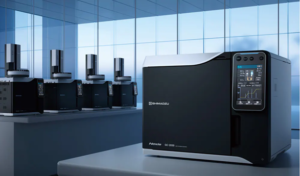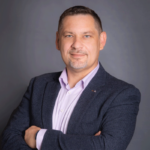Shimadzu Principal User Interview – Dr Emer Shannon

Dr Emer Shannon is a natural products chemist specialising in seaweed bioactive compounds for nutraceutical and functional food applications. Currently completing a Marie Skłodowska–Curie postdoctoral fellowship in seaweed as a source of novel bioactives for gut and metabolic health.
My instrumental background is primarily in HPLC and FTIR. During my PhD at Technological University Dublin, I optimised enzymatic-assisted extraction of the xanthophyll, fucoxanthin, from seaweeds, using FTIR and HPLC to characterise and quantify the extracts.
What are you currently working on and how Shimadzu Gas Chromatography (GC) got involved in your study?
My current project involves the sequential extraction of various components from the Classes of red, brown, and green seaweeds, and the assessment of their bioactivity in enzymatic inhibition assays and as prebiotics for gut bacteria. These components include lipids, polysaccharides, proteins, and polyphenols. Since algal lipids are known to contain health-beneficial polyunsaturated fatty acids, I wanted to use gas chromatography to separate, identify, and quantify the fatty acid methyl esters (FAME) in my lipid fractions after transesterification.
How would you describe your experience using Shimadzu and how does it compare to other instrumentation you have used in the past?
 Chromatography separation units that I have previously used were at least twenty years old and had been purchased second hand from pharmaceutical companies. It was a novel experience working with a brand new GC unit that did not require days of flushing and equilibrating before use. The Shimadzu Nexis GC-2030 that I used for FAME analysis gave extremely accurate and repeatable results. The user interface and software have a lot more options than GC instruments I have previously used. Its accuracy meant there was no requirement for an internal standard. The separation of the 37 FAME standard peaks was excellent and did not require the usual, laborious manual integration of co-eluting trans/cis isomers. The on-site training and post-analysis advice I received was crucial in enabling me to work confidently with the GC unit and the connected software.
Chromatography separation units that I have previously used were at least twenty years old and had been purchased second hand from pharmaceutical companies. It was a novel experience working with a brand new GC unit that did not require days of flushing and equilibrating before use. The Shimadzu Nexis GC-2030 that I used for FAME analysis gave extremely accurate and repeatable results. The user interface and software have a lot more options than GC instruments I have previously used. Its accuracy meant there was no requirement for an internal standard. The separation of the 37 FAME standard peaks was excellent and did not require the usual, laborious manual integration of co-eluting trans/cis isomers. The on-site training and post-analysis advice I received was crucial in enabling me to work confidently with the GC unit and the connected software.
What is next for your research group?
I plan to mine seaweeds and microalgae for health applications such as heavy metal chelation and bioremediation.
Do you have any new analytical techniques or technologies you hope to explore in the future?
Yes, cold vapour atomic absorption spectrometry to detect toxic metals such as mercury in food products.
Where do you see yourself in five years?
Continuing my research with a more diverse range of seaweeds and microalgae for food and health applications.
For information on Shimadzu gas chromatography (GC) hardware and software:
Sebastian Jurek is an application consultant with Mason Technology with specialist knowledge in the Shimadzu range of liquid and gas chromatography systems. Get in touch with Sebastian today if you would like further information on our range of Shimadzu products.
 Sebastian Jurek
Sebastian Jurek
Application Consultant for Shimadzu Chromatography
E: sjurek@masontec.ie
M: +353 87 436 4185
T: +353 1 4154422
RECENT POST
Mason Technology is one of Ireland's Best Workplaces&#x...
Apr 18, 2024
NewsWebinar: Thinking outside the mouse: ex-vivo dissection...
Apr 11, 2024
WebinarsUnderstanding Buffers in Liquid Chromatography
Apr 10, 2024
BlogExploring Texture Analysis in advancing Medical Device ...
Mar 26, 2024
BlogFreeze Drying Adviser Vol.2: Illustrated Toolkit for Ge...
Mar 13, 2024
White PapersSolvents Mixing Ratio in Liquid Chromatography
Mar 06, 2024
BlogMason Technology makes Ireland's Best Workplaces™...
Feb 29, 2024
NewsFreeze Drying: Basic Theory & Applications
Feb 16, 2024
White Papers
